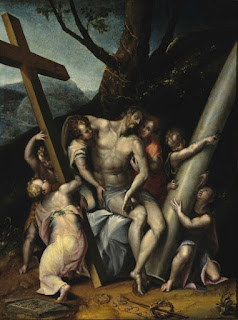Italian who had major influence on French art
_(14803742183).jpg) |
| A woodcut portrait of Francesco Primaticcio from about 1648 |
Primaticcio spent almost two thirds of his life in France, where he rose to be superintendent of works at the Château de Fontainebleau, the former medieval castle that was turned into an opulent Renaissance-style palace by François I of France.
Primaticcio trained as an artist in Bologna under Innocenzo da Imola before moving to Mantua to study with Giulio Romano, a former pupil of Raphael whose style helped define Mannerism.
He assisted Romano in his work on the decorations of the Palazzo del Te in Mantua, a project that refined his skills in fresco painting and architectural ornamentation.
Romano’s trust and belief in Primataccio’s talent was such that when François I invited Romano to assist in the redecoration of his expanded Fontainebleau palace in 1532, seeking to enrich the artistic grandeur of his court, Romano sent Primaticcio in his place.
Primaticcio soon became one of the leading artists at Fontainebleau, where he worked alongside Giovanni Battista di Jacopo, the Florentine painter also known as Rosso Fiorentino.
Following Fiorentino's death in 1540, Primaticcio took control of the artistic direction at Fontainebleau, overseeing the decoration of its grand halls and galleries.
His work at Fontainebleau was characterized by stucco reliefs, elaborate frescoes, and mythological themes, which became hallmarks of the French Mannerist style. Niccolò dell'Abbate, a Mannerist painter from Modena, was one of his team.
 |
| The Château de Fontainebleau, southeast of Paris, where Primaticcio spent much of his working life |
Primataccio’s compositions featured elongated figures, dynamic movement, and intricate detailing, influencing generations of French artists to follow.
He returned to Rome for a couple of years to purchase artworks for François I. He also took casts of the best Roman sculptures in the papal collections, some of which were recreated in bronze to decorate the parterres at Fontainebleau.
Primaticcio’s crowded compositions and graceful figures set a precedent for French painting. His masterpiece, the Salle d’Hercule, occupied him and his team for decades, showcasing his ability to blend classical mythology with courtly elegance.
Other notable works at Fontainebleau included scenes from the Life of Alexander the Great, for the bedchamber of the duchesse d’Étampes, and eight mythological scenes for the ceiling of the Galerie d’Ulysse. He is noted as one of the first artists in France to replace religious themes with those of classical mythology.
Primataccio’s design for the ceiling of the chapel of the Hotel de Guise in Paris, executed in 1557, was his last major work. For the last decade of his life, he worked with the sculptor Germain Pilon on the tomb of Henri II in the abbey church of Saint-Denis near Paris. He designed the Valois Chapel at Saint-Denis, which was completed after his death.
After the death of François I in 1547, Primaticcio remained a court painter under Henri II and François II, continuing to shape the artistic direction of France. His stylistic innovations influenced the development of French Mannerism, to which he introduced a quiet French elegance.
Primaticcio died in 1570 in Paris. His contributions to the School of Fontainebleau cemented his reputation as a master of Mannerism. His ability to merge Italian Renaissance techniques with French artistic traditions ensured his place among the most influential artists of the 16th century.
 |
| Mantua's Palazzo del Te was considered to be Giulio Romano's greatest work |
The Palazzo del Te in Mantua, where Primaticcio worked for part of his time in the city, was designed for Federico Gonzaga as a summer residence. It is a fine example of the Mannerist school of architecture and is considered to be Giulio Romano’s masterpiece. The name for the palace came about because the location chosen had been the site of the Gonzaga family stables at Isola del Te on the edge of the marshes just outside Mantua’s city walls. After the building was completed in about 1535, a team of plasterers, carvers and painters worked on the interior for ten years until all the rooms were decorated with beautiful frescoes.
 |
| The porticoed square adjoining the Basilica di Santa Maria dei Servi in Bologna |
In his youth, Primaticcio trained in Bologna, his home city, in the workshop of Innocenzo di Pietro Francucci da Imola, a painter and draughtsman generally known as Innocenzo da Imola. Visitors to Bologna can see some of Innocenzo's work in the Basilica of Santa Maria dei Servi, a great example of Gothic architecture that stands on Strada Maggiore, a street in central Bologna that is part of the Roman Via Emilia. It runs, with its porticoes between medieval houses, buildings and churches, from Piazza di Porta Ravegnana to Porta Maggiore. The church also houses a Madonna enthroned with the Child and angels by Cimabue.
Also on this day:
1306: The birth of Andrea Dandolo, Doge of Venice
1885: The birth of composer Luigi Russolo
1888: The birth of architect Antonio Sant’Elia
The feast day of Pope Saint Pius V (d:1572)
.jpg)













